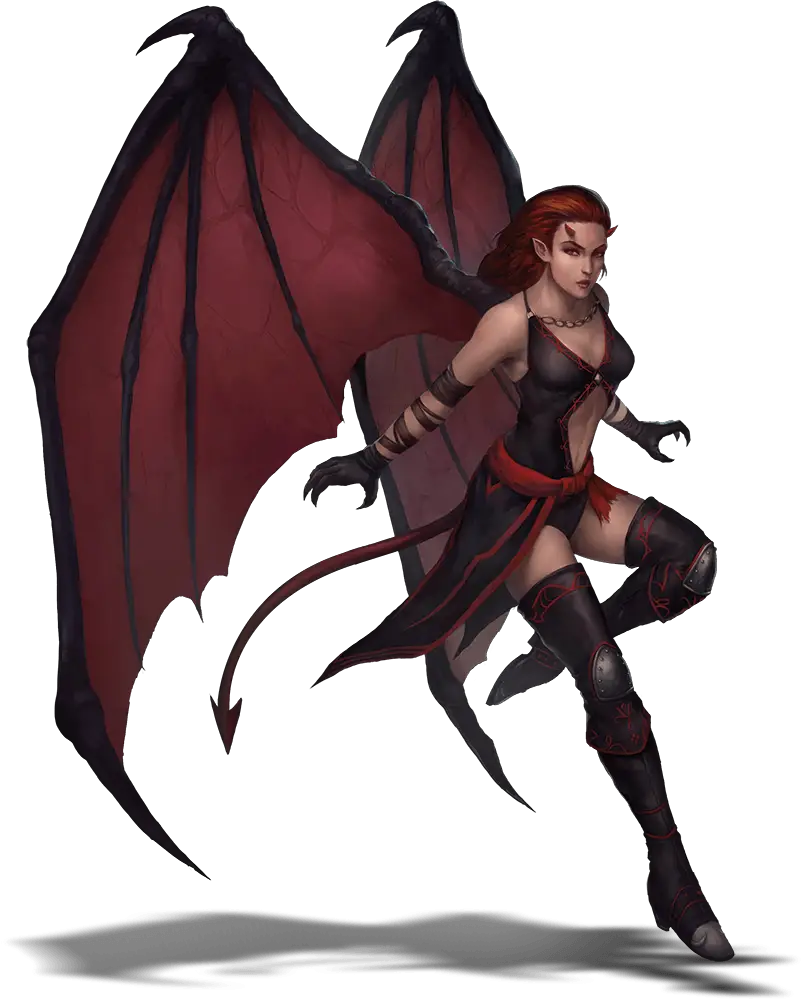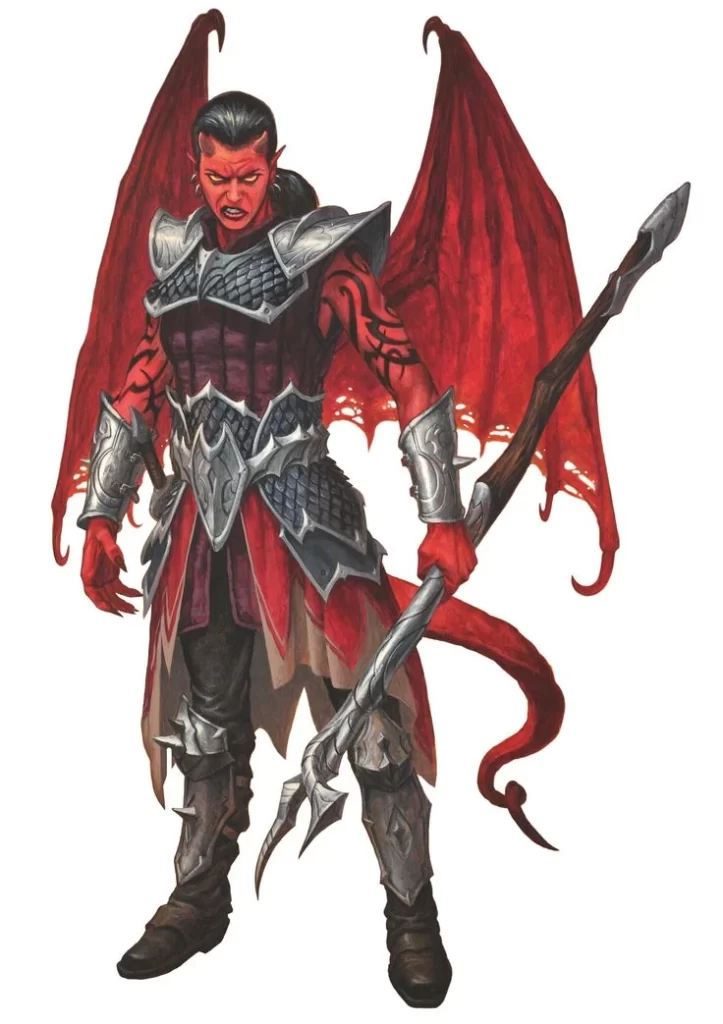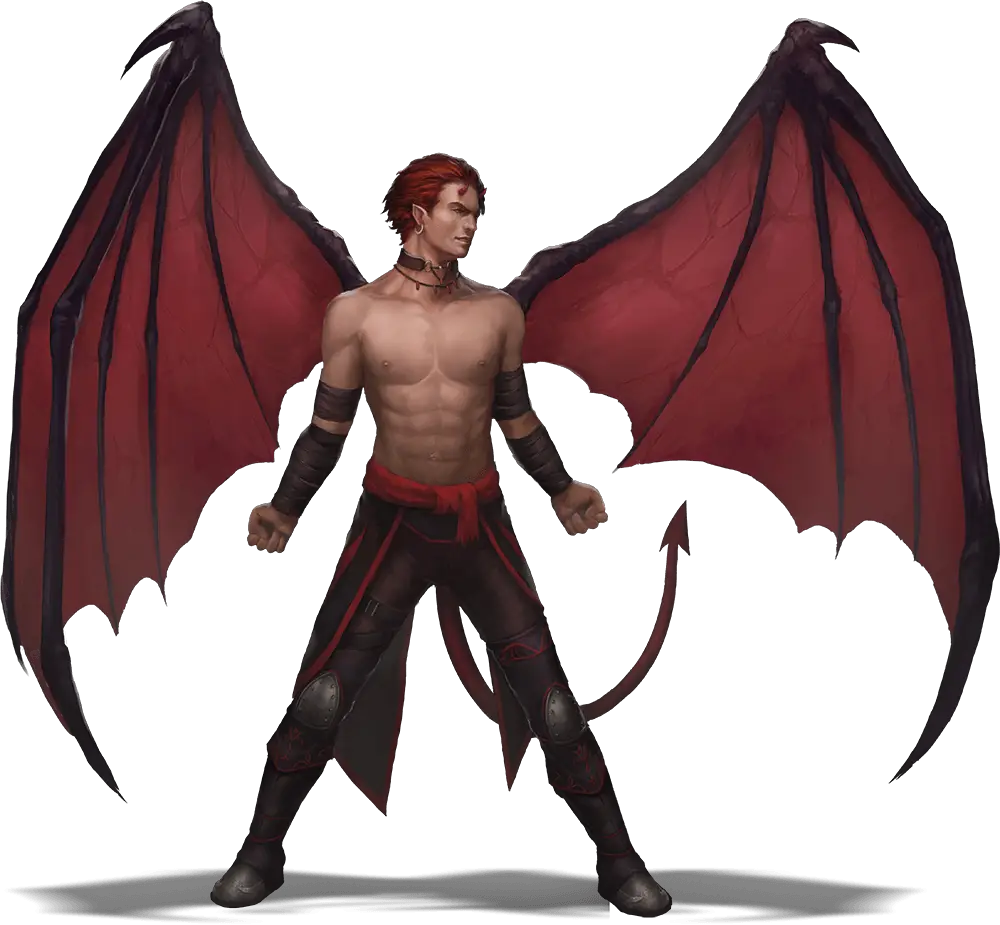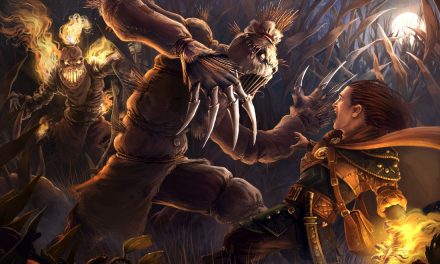Succubus and Incubus are beautiful, charming, and (most importantly) deadly.
Indeed, these fiends love nothing more than tempting and corrupting the souls of mortals that they encounter.
Beware these creatures’ charms and resist their temptations, dear adventurer!
For only ruin awaits you if you don’t…
Today we’re taking a closer look at the Incubus and Succubus in D&D 5e!
What Are Incubus and Succubus?
Incubus and Succubus are both the same type of shapechanging fiend.
Traditionally, those who favor a female form are known as a Succubus while those who favor a male form are known as an Incubus.
However, these beings are also known to change between the two forms. This is especially true when they have set their eyes on a target that they are trying to corrupt.
Whichever form an Incubus or Succubus is encountered, they prefer to keep their true form a secret.
Most mortals would only see this true form if the Incubus/Succubus is threatened or has been killed. Though both of those situations are also incredibly rare.
Beautiful But Evil
As creatures who love corrupting mortals and manipulating them to give in to their desires, it’s no surprise that Incubus and Succubus rely on their subtlety and charms.
Once one of these fiends has identified its prey, they get right to work.
They begin by visiting their target while they’re sleeping. Whispering taboo desires and encouraging the sleeping victim to pursue their most debaucherous appetites, the Incubus/Succubus plants a type of mental seed in the victim’s mind.
Sometime later, once their prey has allowed these thoughts to linger in their mind, the Succubus/Incubus will make their appearance.
Whatever their prey’s desires, the Incubus/Succubus takes a form that the mortal would find irresistible. Naturally, they keep their true fiendish form (wings, horns, claws) as a secret… for now…
As the mortal is further seduced or befriended by the fiend, their new “friend” gives them all the “little push” they need to start indulging in their desires.
The Incubus/Succubus’ goal is simple: they want to see their prey become completely corrupted.
Once their prey has been fully corrupted, the Succubus/Incubus lays claim to their soul. Upon killing their victim, the mortal’s tainted soul is doomed and sent to the Lower Planes.
Related: 10 D&D Monsters From Real World Mythology
Free Will
While Incubus and Succubus can magically charm others, they only do so in self-defense or other emergencies.
Magically charming their victim to indulge their deepest desires wouldn’t qualify as actually corrupting a person.
To successfully corrupt a mortal’s soul, the mortal must complete the three betrayals of Thought, Word, and Deed.
For this to happen, the mortal must give in to these desires of their own free will.
Of course, the Succubus/Incubus is right there to guide them along and encourage them to make certain decisions…
This is perhaps why Incubus and Succubus are so notoriously feared!
After all, you could look at someone who has fallen under enchantment magic and been compelled to do bad things and feel bad for them. They’re obviously victims!
But those who lean on the sweet words of an Incubus or Succubus…
They’ve done what they have done of their own free will. For that, they have willingly sacrificed their very soul without the need for things like contracts or magic!
This is also what makes certain mortals more appealing targets than others.
To the Incubus/Succubus, it might take longer to corrupt someone with more discipline like a high priest or a captain of the guard. But how diabolically sweet would it be to make them fall from grace?

The Kiss of Death
As beings that symbolize the sin of lust, there is a cruel emptiness to the kiss of a Succubus or Incubus.
Neither the fiend nor the recipient receives any kind of satisfaction from this kiss. It is instead empty, hollow, and so infinitely bleak that it actually causes severe mental pain in the recipient.
(And I thought that MY ex was bad!)
But jokes aside, this is typically the final farewell that the Succubus or Incubus gives their victim.
As their prey’s life is drained out of them and their soul is sent to the Lower Planes, the Incubus/Succubus goes on their way in search of their next “friend.”
And I thought MY ex was… oh wait… I already used that joke…
Fiendish Family Values
An interesting bit of lore about Incubus and Succubus is that they can reproduce.
Most commonly, they’ll mate with each other to create more of their kind.
After all, they tend to find themselves in high demand throughout the Lower Planes such as in the service of Asmodeus and the demon lord Graz’zt.
You’ll commonly also find them in the service of Hags (especially Night Hags), powerful demons and devils, yugoloths, and (one of my favorite creatures) Rakshasas.
But what about the mortals that Incubus/Succubus seduce?
While it’s not particularly common, it is possible for the unholy union of a humanoid and Incubus/Succubus to result in a child.
These beings are known as Cambions and are typically just as wicked and awful as their Succubus/Incubus parent.
(If you’d like me to write more about Cambions, let me know in the comments!)

Incubus and Succubus Traits and Features in D&D 5e
Traits
It’s not surprising that Incubus and Succubus have a very high Charisma score. But their Dexterity score is also respectable!
These are creatures that prefer to work “behind the scenes” from the shadows. They have much less interest in a direct physical confrontation unless it’s absolutely necessary or they have an opportunity to prey on the weak.
Thanks to their 60ft of telepathy, they can communicate with someone from the safety of a hiding place (or the ethereal plane) without even needing to show themselves!
Though they are also fairly resilient thanks to their fiendish origins.
Incubus and Succubus both have resistance to cold, fire, lightning, and poison damage. Additionally, they resist nonmagical bludgeoning, piercing, and slashing damage which can make them especially painful to deal with.
Of course, that’s assuming that you’re able to hit them to begin with!
With 60 feet of flying speed, these fiends can outmaneuver most of their foes with ease!
Related: 12 Monsters That Will Instantly Kill Characters!
Features
Incubus and Succubus have some impressive features on their stat block.
There is definitely a focus on their typical goals of manipulating and then preying on the weak before making a quick escape to go do it again!
Thanks to their Telepathic Bond feature, Incubus and Succubus can stay in constant contact with someone that they have charmed.
This gives their telepathy unlimited range. In fact, the Incubus/Succubus doesn’t even need to be on the same plane as their charmed “friend”!
This especially works well with their Etherealness feature that allows them to enter the Ethereal plane where they are much safer from those who might attack them.
Meanwhile, these fiends’ Shapechanging feature lets them take the form of a small or medium sized humanoid. Hiding their fiendish wings and claws, they can move throughout a city or settlement like a wolf in sheep’s clothing.
But it’s the Incubus/Succubus’ Charm feature that is possibly the most worrying.
A creature that the Incubus/Succubus can see within 30 feet of them has to beat the DC 15 Wisdom saving throw or be charmed FOR AN ENTIRE DAY.
During that time, the charmed person obeys the Incubus/Succubus’ orders whether spoken verbally or telepathically. Though, suffering harm or being given a command that would cause them to harm themselves they get another saving throw.
Of course, such a charmed “friend” is chosen carefully. The Incubus or Succubus can only have one charmed “friend” at a time!
When the time has come to dispose of a charmed (or willing) target, the Incubus/Succubus uses their Draining Kiss feature.
As a DC 15 Constitution saving throw, this can be tough for many low-level characters to beat. It also deals an astounding 5d10+5 psychic damage and reduces the victim’s hit point maximum by the amount of damage taken.
If Draining Kiss reduces a character to zero hit points, they don’t even get to make death saving throws and instead just die outright!
If they don’t instantly die, the character will still have their maximum hp reduced until they finish a long rest.

Running Incubus and Succubus for Dungeon Masters
Incubus and Succubus have all the makings of a master manipulator who can be a constant thorn in the party’s side at lower (or even mid-tier!) levels.
In fact, they could even make for an interesting boss for a low-level party to have to outwit!
Whatever the case, an Incubus or Succubus isn’t looking for a fight. They prefer to keep their dealings as “out of combat” as possible.
There is some incredibly fun roleplaying potential here.
The Incubus/Succubus is going to pick a target and use that character’s fears, bonds, and ideals to attempt to manipulate them.
Heck, the fiend might have even charmed the character while they were sleeping to “go meet the Elvish woman in the red cloak by the lake first thing in the morning”.
When the character arrives at the lake, they then meet the new friend that they dreamed would be of help to them. Of course, unknown to the player, this is actually the Succubus/Incubus in disguise!
Even after the Charm wears off, the character will believe they have a new friend. The Charm was only to start this whole process and give the Succubus/Incubus the “in” they needed.
To reduce the risk of raising suspicions from the rest of the party, the fiend will certainly ask for their target’s discretion. “The others will get jealous of what we have” or “I want to be only yours” can make sense if given the right context.
As the Succubus/Incubus worms its way into the character’s life, mind, and heart, they will gradually start making requests that get more “corrupt” in nature. Subtlety and patience are the names of the game here!
While the Succubus/Incubus’ Draining Kiss could be used against a target who is under their Charm effect, it’s more likely to be effective if the target is willing.
If You Must Fight…
Incubus and Succubus are CR 4 creatures which means that it’s considered “fair” for a part of four level-4 adventurers to encounter one.
However, these creatures will almost always have some kind of ally or defender if they’re encountered. Realistically, that ally could even be one of the party’s own members thanks to their Charm feature!
One moment the party could think they have the fiend cornered only to then have their own Wizard start lobbing fireballs at the rest of the party.
In a combat situation, the Incubus/Succubus’ primary goal is simple: to get away.
Between their flying speed and their Etherealness feature, this shouldn’t be particularly difficult for them. They also have their Shapechanging feature and a solid Stealth score which can aid in their escape if necessary.
It’s almost anticlimactic, but these are creatures who specifically prey on those who are at their weakest and most vulnerable. A direct confrontation would almost never go favorably for the Incubus/Succubus.
If the combat has started because the fiend’s true nature was revealed, they might need to wait a little while before they come back.
When (or possibly “if”) they do reenter the party’s lives, it will certainly be under a new identity. They’ll also try a new approach and won’t make the same mistakes twice!
A Succubus/Incubus that is somehow prevented from escaping to the Ethereal plane will attempt to fly away.
If that is not an option and they find themselves cornered, they’ll likely make one last-ditch effort to attempt to charm a party member into defending them.
From there, they have no choice but to strike with their claws until they see an opening to escape.

Encountering Incubus and Succubus as a Player
First and foremost, to make an Incubus/Succubus memorable to the story, players should absolutely avoid metagaming.
While that’s good practice anyway, it’s especially true for creatures like this that lean heavily on the roleplaying aspect of D&D.
Approach the situation as your character, not as a player in a game.
Having said that, there are some tell-tale signs that characters would possibly notice if a party member finds themselves wrapped around a Succubus/Incubus’ finger.
Perhaps someone spots the Paladin swiping some coins from a beggar’s bowl or the temple’s collections plate.
Maybe the Wizard hasn’t been their typical studious self and is instead spending every night at the tavern getting viciously drunk and partying.
It would be natural for characters to respond to a noticeable shift in behavior, especially if it contradicts how that character typically is.
From there it becomes a process of trying to figure out who or what is behind these changes in the character’s behavior.
Fighting an Incubus/Succubus
But what about when you manage to corner an Incubus or Succubus?
It won’t be an easy thing to track down the Incubus or Succubus that is causing so much trouble. But if you manage to do so, you’ll need to act very quickly if you want to deal with them.
As I mentioned in the previous section, these aren’t fiends who are going to stick around if things get hairy for them. The second they have an opening to get away, they’re going to take it.
If you plan to slay an Incubus or Succubus, you’ll need to act quickly and decisively.
Unless you’ve got some kind of macguffin that will stop them from entering the Ethereal plane, that will be what they do on their first turn. Especially at low levels, this makes them basically invincible to you.
From there, you need to stop them from flying away.
If you’re indoors, make sure to block the windows and doorways so they can’t escape.
If you’re outside or blocking all of the exits isn’t an option, find a way to grapple or restrain the fiend. They aren’t particularly strong, so if you can catch them, it should be easy to keep them pinned down.
Lastly, make sure that you have backup plans in case any member of the party gets charmed by the Incubus/Succubus.
If you want to take one of these fiends down, it will take careful preparation and decisive actions.
You’ll need to first outwit them at their own game (perhaps using a party member as a kind of “honeypot” trap) and then strike quickly.
Also, make sure that you have some way of getting around their weaknesses. Cold, Fire, Lightning, and Poison damage types aren’t going to be particularly helpful.
Additionally, you’ll need to make sure that your heaviest hitter has a magical weapon to get around the Incubus/Succubus’ resistance to nonmagical damage!
Conclusion – Incubus and Succubus in D&D 5e
I hope you’ve found this guide to the Incubus and Succubus helpful!
There is actually quite a bit of nuance to these fiends that goes well beyond being simple seducers.
While most people think more along the lines of “Rated R” type content with these monsters, they can easily be kept in a more “PG-13” zone.
What matters most to them is the corruption of mortals. So even having them as the “devil on your shoulder” can make for some very interesting scenarios.
It makes them adaptable to many situations and adventure types while keeping them interesting and unique.
Honestly, I think the biggest weakness of these creatures is how much they rely on the group’s roleplaying.
If your group focuses on the roleplaying aspect of D&D, these can make for an incredibly memorable enemy. However, they struggle to take hold in a group that isn’t quite as RP-heavy.
Though placing the manipulations of an Incubus or Succubus at the center of an intrigue-focused campaign could make for some truly diabolical fun!
Got a memorable encounter with one of these fiends that you’d like to share? Let’s chat in the comments!










